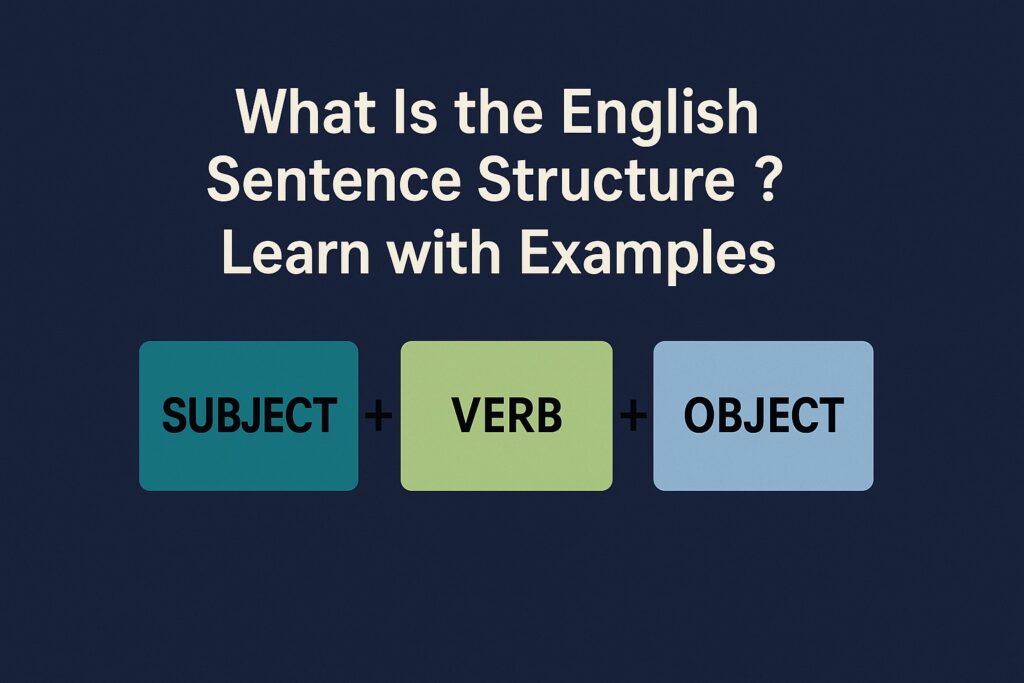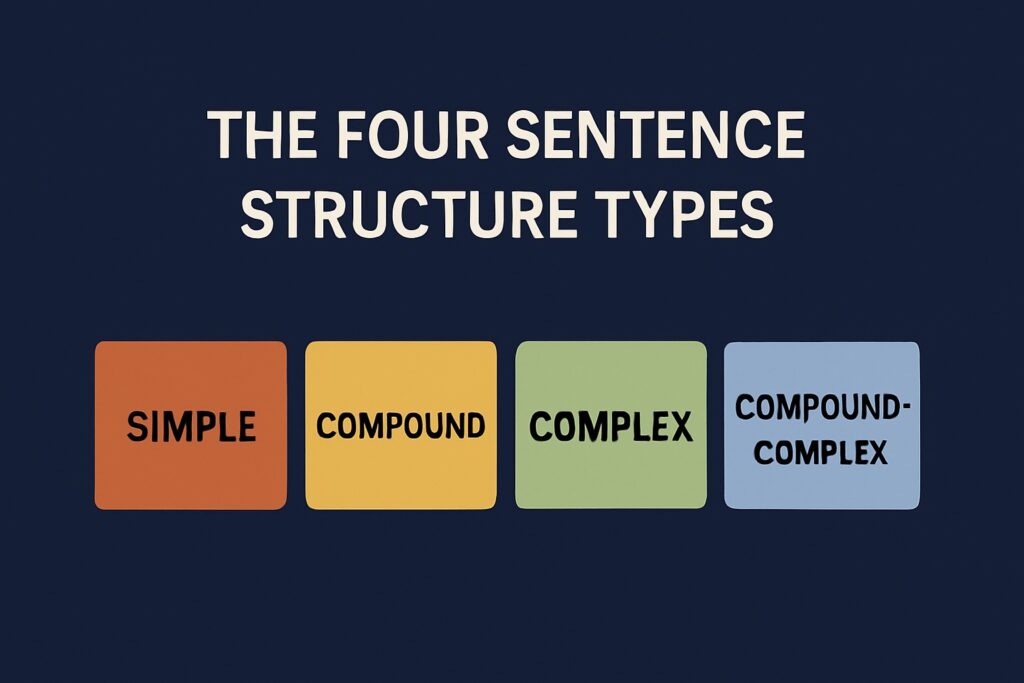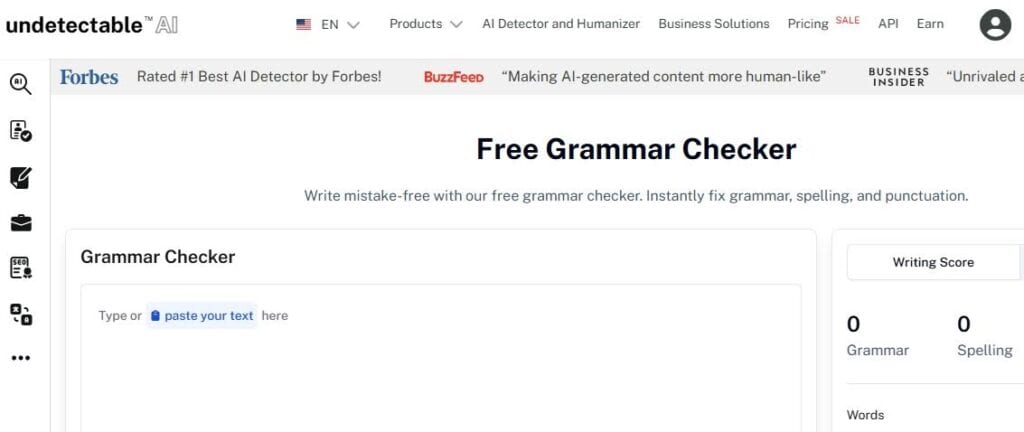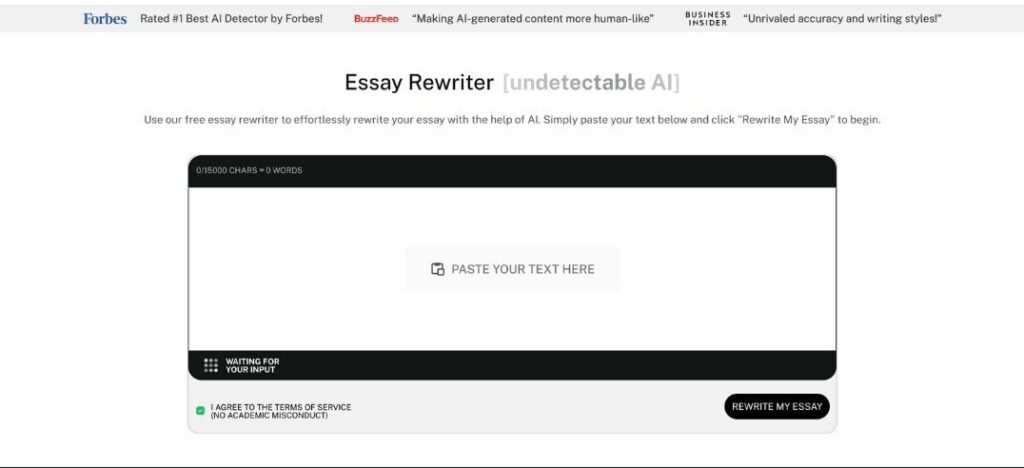Want in on a little secret? English sentences aren’t built. They’re wired.
Wired to make sense, to flow, to carry meaning. And when even one wire is out of place, the whole message shorts out.
You might not realize it, but every time you write or speak, you’re running a kind of invisible system.
If that system isn’t clear to you, it’s only a matter of time before confusion hits.
In this blog, I’ll tell you what English sentence structure actually is, how it works under the hood, and how to use it correctly.
Let’s get into it.
Key Takeaways
- English sentence structure follows a basic pattern, i.e., Subject + Verb + Object. Knowing this helps you build clear, complete sentences.
- There are four main sentence types: simple, compound, complex, and compound-complex.
- Word order matters a lot in English. Unlike languages like Japanese (which put the verb last), English sticks to a fairly strict order.
- Common mistakes, like fragments, run-ons, and comma splices, can be fixed once you understand sentence parts.
What Is Sentence Structure in English?

Sentence structure in English is how we organize words, phrases, and clauses to create clear and meaningful sentences.
Let’s take a look at what shapes the English sentence structure.
Core Elements (Subject + Predicate)
Every complete sentence must have these two things:


Never Worry About AI Detecting Your Texts Again. Undetectable AI Can Help You:
- Make your AI assisted writing appear human-like.
- Bypass all major AI detection tools with just one click.
- Use AI safely and confidently in school and work.
- The Subject: Who or what the sentence is about
- The Predicate: What the subject is doing, being, or experiencing
- Sara dances.
Sara (subject) | dances (predicate) - The tall man in the red jacket is my uncle.
The tall man in the red jacket (subject) | is my uncle (predicate)
Now this structure holds true in questions or unusual word orders, too. For example:
- Is she coming?
She is the subject | is coming is the predicate
If your sentence doesn’t have a subject or a predicate, it will be considered incomplete.
Clauses vs. Phrases
A clause is made up of a subject and a verb. It has two main types:
- An independent clause makes a complete thought and can stand alone. Example: She opened the window.
- A dependent clause needs more information to complete the thought. Example: Because she opened the window… (We’re left waiting for more).
A phrase, on the other hand, consists of two or more words that work together but don’t include a subject and a verb.
Such as:
- After the meeting
- In the middle of the street
- With great excitement
Phrases add detail and description, but they can’t stand alone as sentences.
Basic Sentence Patterns
Mainly, there are four types of sentence structures in English. These are the building blocks that allow you to express simple ideas or link multiple ideas together.
- Simple Sentence
- Compound Sentence
- Complex Sentence
- Compound-Complex Sentence
If you’re new to learning sentence structures, you should try using Ask AI by Undetectable AI.
Just type in your sentence and ask, “Can you identify the subject, verb, and structure type of this sentence?”

It will break down your sentence, explain each part (subject, verb, object, etc.), and even tell you what kind of sentence it is (simple, compound, complex, or compound-complex).
Let’s look at English sentence structure types in further detail:
The Four Sentence Structure Types
Sentence structure shapes your grammar and also how your ideas land.
When you have a grip on the four sentence types in English, you can add variety, clarity, and nuance to your writing and speech.

Simple Sentences
A simple sentence contains just one independent clause, i.e., a subject and a verb that form a complete idea.
Don’t let the word “simple” fool you, though. Simple sentences can include modifiers, compound subjects, or verbs and still be powerful and clear.
- The dog barked.
- My sister and I love rainy mornings.
- She ran quickly through the empty streets.
These sentences come in handy in English-to-ASL translation because of their clarity and directness.
If you ever look closely at how people translate English to ASL sentence structure, you’ll realize that short, clear sentences are often easier to adapt and interpret.
2. Compound Sentences
A compound sentence links two or more independent clauses.
You can link them using a word like ‘and,’ ‘but,’ or ‘so,’ or simply use a semicolon if the two ideas are related quite closely.
- I wanted to go for a walk, but it started raining.
- She studies hard, and she always asks thoughtful questions.
- The sun set; the streetlights flickered on.
This structure allows you to show contrast, cause-and-effect, or balance between ideas within one sentence.
3. Complex Sentences
A complex sentence is made with one independent and one dependent clause. The dependent clause here cannot stand alone. It needs the main clause to complete the thought.
- Although she was tired, she kept working.
- We cancelled the trip because the weather was terrible.
- He didn’t know that she had already left.
Complex sentences help you show relationships between ideas, time, reason, condition, contrast, etc.
They’re essential when you want to explain something beyond the basic action.
If you speak Spanish, this kind of sentence might actually come pretty naturally.
A lot of people compare Spanish sentence structure vs English, and while the order of words can be different, both use connecting words like “because,” “although,” or “if” to link ideas and add more meaning.
4. Compound-Complex Sentences
A compound-complex sentence is the most advanced type.
It combines two or more independent clauses with one or more dependent clauses.
- Although he didn’t feel well, he went to the meeting, and he gave the presentation anyway.
- Because the power went out, we lit some candles, and we played cards by flashlight.
- While I was cooking dinner, the kids were doing their homework, and the dog kept barking at the door.
These sentences can work well when used the right way, but if you don’t use the right punctuation or words, they can be challenging to understand.
Sometimes it’s hard to tell if a sentence is complete or if you’ve used the right punctuation. When that happens, use this Grammar Checker by Undetectable AI.

It can spot missing parts of a sentence, too many commas, or sentences that go on too long without a proper break. It’s an easy way to catch small mistakes and fix them right away.
Word Order in English Sentences
In English, the order of words in a sentence really matters.
You can have all the right words, but if they’re in the wrong place, the sentence sounds strange.
- Standard Pattern: Subject – Verb – Object
Most English sentences follow this basic structure: Subject + Verb + Object. For example: The cat (subject) chased (verb) the mouse (object).
- Adjective and Adverb Placement
Adjectives describe nouns, and in English, they almost always come before the noun.
We don’t say “an apple red” or “a movie interesting”. That word order might work in other languages, but not in English.
Adverbs describe verbs, adjectives, or other adverbs. They can move around more in a sentence, but there are still common patterns.
- Exceptions and Inversions
Of course, English wouldn’t be English without a few rule-bending moments. Sometimes we flip the normal word order for style, emphasis, or in questions.
- Are you coming?
- Never have I seen such a mess.
It doesn’t matter how hard you try; sometimes, all your sentences start the same way and feel too flat. Good news? You don’t have to fix this on your own.
Undetectable AI’s AI Essay Rewriter can help you rewrite your clunky sentences.
It skillfully changes sentence length, structure, and word flow while keeping your meaning the same.

Common Errors and Fixes
Even native speakers slip up when it comes to sentence structure.
If you’re learning English, knowing what to watch out for can help you learn faster.
- Fragments (Incomplete Sentences)
A sentence needs both a subject and a verb, and it must express a complete thought. Starting with words like “because,” “although,” or “if” leads to fragments if you don’t finish the sentence.
- Run-On Sentences
Run-ons happen when two full sentences are squished together without proper punctuation or connecting words. You can fix them by adding a period, a semicolon, or a conjunction like and, or but.
- Comma Splices
This error happens when two full sentences are joined by just a comma. A comma isn’t strong enough on its own. You must add a connecting word or separate the ideas.
- Wrong Word Order
English follows a fairly strict Subject–Verb–Object word order. That’s different from many other languages.
For example, when people compare Japanese sentence structure vs English, they’ll notice that Japanese often places the verb at the end.
- Repetitive Sentence Patterns
Too many short, similar sentences can make writing feel flat. Try combining related actions or changing up English sentence structure to keep things flowing.
Bonus Tip: If your sentence sounds a bit awkward or doesn’t follow grammar rules, try using this AI Humanizer by Undetectable AI. It can help rewrite your sentences so they feel smoother, clearer, and more natural.

What Languages Have the Same Sentence Structure as English?

So far, we have learned that English follows a Subject–Verb–Object (SVO) sentence structure.
Do other languages follow the same pattern? If not, what languages have the same sentence structure as English?
Several major languages use this same basic word order, including:
- Spanish
- French
- Chinese (Mandarin)
- Italian
- Swahili
Languages like Japanese and Russian, on the contrary, use an opposite structure. Let’s pick one language from each category and see how it varies from English!
Spanish Sentence Structure vs English
Spanish also follows the SVO pattern, so many sentences in Spanish feel quite similar to their English translation.
For example:
- English: She reads the book.
- Spanish: Ella lee el libro.
However, Spanish is more flexible with word order because of verb conjugations. Sometimes the subject is dropped entirely if the verb form makes it clear who’s doing the action.
Japanese Sentence Structure vs English
Japanese is very different. It follows a Subject–Object–Verb (SOV) pattern.
For example:
- English: I eat sushi.
- Japanese: I sushi eat. (Watashi wa sushi o tabemasu.)
Also, Japanese often leaves out the subject if it’s understood from context, and word particles (like wa and o) help show the role of each word in the sentence.
This makes Japanese sentence structure feel very different from English.
Learning sentence structures in different languages is no piece of cake. But Undetectable AI’s AI Chat tool can help you with it.
Run your sentences by this tool, and it will help you fix them.

Start exploring—our AI Detector and Humanizer are waiting in the widget below!
Final Thoughts
If you made it this far, congrats.
You have officially spent more time thinking about English sentence structure than 90% of people ever will. And honestly? That’s kind of great.
Just knowing the basics of how English usually works, where things should go, and how to fix stuff when it sounds off can save you a lot of confusion.
You’ll still mess up sometimes. We all do. Even native speakers mix up clauses and run-on sentences. But the more you pay attention, the more natural it starts to feel.
With Undetectable AI’s Ask AI, AI Essay Rewriter, AI Chat, AI Humanizer, and Grammar Checker, you can sharpen your skills, fix errors faster, and boost your writing confidence.
And to learn faster and quickly overcome your mistakes or confusions, use Undetectable AI—your all-in-one writing improvement partner.
